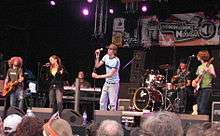Koningsdag
| Koningsdag | |
|---|---|
 People dressed in orange on the canals of Amsterdam in 2010 | |
| Observed by | Kingdom of the Netherlands (Netherlands, Aruba, Curaçao, Sint Maarten) |
| Type | National holiday |
| Significance | Birthday of King Willem-Alexander of the Netherlands |
| Celebrations | Partying, wearing orange costumes, flea markets, concerts and traditional local gatherings |
| Date | 27 April (26 April if 27 April is a Sunday) |
| Frequency | annual |
Koningsdag (Dutch pronunciation: [ˈkoːnɪŋsˌdɑx]) or King's Day is a national holiday in the Kingdom of the Netherlands. Celebrated on 27 April (26 April if the 27th is a Sunday), the date marks the birth of King Willem-Alexander.[1]
Up until 2013, when Queen Beatrix abdicated and was succeeded by her son Willem-Alexander, the holiday was known as Koninginnedag (Dutch pronunciation: [koːnɪˈŋɪnəˌdɑx]) or Queen's Day and was celebrated on 30 April.
The holiday was initially observed on 31 August 1885 as Prinsessedag or Princess's Day, the fifth birthday of Princess Wilhelmina, heir to the Dutch throne. On her accession in November 1890 the holiday acquired the name Koninginnedag, first celebrated on 31 August 1891. In September 1948, Wilhelmina's daughter Juliana ascended to the throne and the holiday was moved to Queen Juliana's birthday, 30 April. The holiday was celebrated on this date from 1949.
Juliana's daughter, Beatrix, retained the celebration on 30 April after she ascended the throne in 1980, though her birthday was on 31 January.[2] Beatrix altered her mother's custom of receiving a floral parade at Soestdijk Palace, instead choosing to visit different Dutch towns each year and join in the festivities with her children. In 2009, the Queen was celebrating Queen's Day in the city of Apeldoorn when a man attempted to attack her by trying to ram the Royal family's bus with his car; instead he drove into a crowd of people and crashed into a monument: seven people in the crowd were killed, as was the driver.
Queen Beatrix abdicated on Koninginnedag 2013, and her son, Willem-Alexander, ascended the throne (the first king since the observance of the national holiday). As a result, the holiday became known as Koningsdag from 2014 on, and the celebration was shifted three days back to 27 April, the King's birthday.
Koningsdag is known for its nationwide vrijmarkt ("free market"), at which the Dutch sell their used items. It is also an opportunity for "orange madness" or oranjegekte, a kind of frenzy named for the national colour.
History
Wilhelmina (1885–1948)
Faced with an unpopular monarchy, in the 1880s the liberals in Dutch government sought a means of promoting national unity.[3] King William III was disliked, but his four-year-old daughter Princess Wilhelmina was not.[4] A holiday honouring King William had been intermittently held on his birthday, and J. W. R. Gerlach, editor of the newspaper Utrechts Provinciaal en Stedelijk Dagblad, proposed that the princess's birthday be observed as an opportunity for patriotic celebration and national reconciliation.[5] Prinsessedag or Princess's Day was first celebrated in the Netherlands on 31 August 1885, Wilhelmina's fifth birthday. The young princess was paraded through the streets, waving to the crowds.[4] The first observance occurred only in Utrecht, but other municipalities quickly began to observe it, organizing activities for children.[5] Further processions were held in the following years, and when Wilhelmina inherited the throne in 1890, Prinsessedag was renamed Koninginnedag, or Queen's Day.[4] By then almost every Dutch town and city was marking the holiday.[5]
The celebration proved popular, and when the Queen came of age in 1898, her inauguration was postponed a week to 6 September so as not to interfere with Koninginnedag.[6] The annual holiday fell on the final day of school summer vacation, which made it popular among schoolchildren.[4] It is uncertain how much Wilhelmina enjoyed the festivities; although writer Mike Peek, in a 2011 magazine article about Koninginnedag, suggests she was enthusiastic,[4] there is a story of Wilhelmina, after a tired return from one of these birthday processions, making her doll bow until the toy's hair was dishevelled, and telling it, "Now you shall sit in a carriage and bow until your back aches, and see how much you like being a Queen!"[7]
Koninginnedag 1902 not only honoured the Queen's birthday, but was celebrated with increased enthusiasm as it marked her recovery from serious illness.[3] Wilhelmina rarely attended Koninginnedag festivities after reaching adulthood.[8] She attended ceremonies for her silver jubilee in 1923, which included massive festivities in Amsterdam and The Hague, despite the Queen's request that large sums not be spent because economic conditions at the time were difficult. To ensure that even the poorer parts of the city were not excluded, bands played simultaneously at 28 locations across The Hague.[9] Wilhelmina made further exceptions for such events as her fiftieth birthday in 1930.[8] During the German occupation of the Netherlands during World War II, Koninginnedag celebrations were banned, and members of the Orange Committees, which organize the holiday events, destroyed their records for fear of German reprisals.[6]
Juliana (1948–1980)
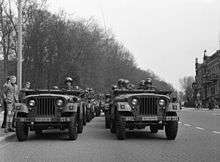
Another summertime birthday celebration in the Netherlands was that of Wilhelmina's mother, Queen-Regent Emma, who after Wilhelmina attained adulthood generally spent her own birthday, 2 August, at Soestdijk Palace in Baarn. Until her death in 1934, Emma received an annual floral tribute from the townsfolk on her birthday. In 1937 Wilhelmina's daughter and heiress, Princess Juliana, took up residence at Soestdijk Palace following her marriage, and the townsfolk made their floral presentation to her, moving the date to Juliana's birthday, 30 April.[8] In September 1948 Juliana ascended to the Dutch throne and from 1949 onwards Koninginnedag was on her birthday.[10] The change in date attracted immediate approval from Dutch children, who gained an extra day of holiday. The first observance of the holiday on the new date included a huge circus at the Amsterdam Olympic Stadium—one not attended by the royal family, who remained at Soestdijk Palace.[11] Queen Juliana retained the floral tribute, staying each year on Koninginnedag at Soestdijk Palace to receive it. The parade became televised in the 1950s, and Koninginnedag increasingly became a national holiday, with workers given the day off.[3] Juliana had a reputation as a "queen of the people", and according to Peek, "it felt as if she invited her subjects to the royal home".[4]
In early 1966 Juliana's eldest daughter, Princess Beatrix, married Klaus-Georg von Amsberg. The marriage was controversial because the new Prince Claus (as he was dubbed) was a German, and Claus himself had served in the German Army during the war. Anti-German riots in Amsterdam marred the wedding day and the following observances of Koninginnedag. Fearing further demonstrations on the holiday, government officials decided to open Amsterdam city centre to the vrijmarkt ("free market") that had long been held on Koninginnedag in the outskirts of town, principally for children. The vrijmarkt occupied the space where demonstrations might have been held, and began a new custom.[4]
Beatrix (1980–2013)
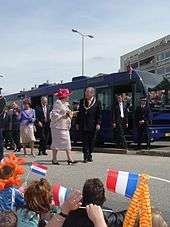
When Queen Beatrix succeeded her mother Juliana on the latter's abdication on 30 April 1980, the new queen decided to keep the holiday on 30 April as a tribute to her mother.[2][3] (If 30 April fell on a Sunday, Koninginnedag was observed the previous day—this occurred most recently in 2006.[12]) The reason was practical as well—Beatrix's actual birthday on 31 January would have been less conducive to the traditional outdoor activities.[10] Rather than remaining at the palace and letting the Dutch people come to her, Beatrix instead usually visited two towns each year for Koninginnedag celebrations.[3] Local crafts and customs were demonstrated for the royal family, who had the opportunity to join in.[13][14]
Koninginnedag celebrations have sometimes been affected or disrupted. In 1988 three British servicemen stationed in Germany who were in the Netherlands for Koninginnedag were killed in Irish Republican Army attacks.[15] In 1996 the celebrations in Rotterdam were dampened by an alcohol ban, put in place following riots earlier in the week after local football club Feyenoord won the Dutch league championship.[16] The Queen's scheduled 2001 visits to Hoogeveen and Meppel were postponed for one year owing to an outbreak of foot-and-mouth disease.[17]
On 30 April 2009, Beatrix and other members of the royal family were at the town of Apeldoorn when a 38-year-old man, Karst Tates, drove his Suzuki Swift automobile into the crowd, narrowly missing the open-top bus the royal family members were riding on.[4][18] Seven people were killed and further celebrations were cancelled.[18] Tates died of injuries sustained in the attack soon afterwards and his exact motives remain unclear, though it appears his target was the royal family.[4] The incident provoked questions about whether the royal family should continue to participate in the celebrations. However, Beatrix indicated that the tragedy would not stop her from meeting her people.[13] In 2010, Beatrix and her family visited Wemeldinge and Middelburg, in Zeeland province. There were no incidents, and afterwards, the Queen thanked Zeeland for giving Koninginnedag back to her family, and to her country.[4]

Queen Beatrix visited the following towns and cities over the years on Koninginnedag:[19]
|
|
On 28 January 2013 Queen Beatrix announced her abdication on 30 April 2013 in favour of her son, Willem-Alexander.[21] Since this date coincided with Koninginnedag the royal family's planned visit to De Rijp and Amstelveen was cancelled, although Koninginnedag 2013 was still celebrated throughout the country.
Willem-Alexander
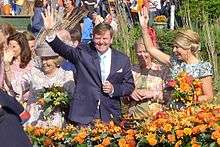
On 30 April 2013, Queen's Day, Willem-Alexander succeeded his mother Beatrix and became the first King of the Netherlands in 123 years. Consequently, from 2014 onwards the name has been changed from Queen's Day to King's Day. The date has also changed from 30 April to 27 April, which is the birthday of Willem-Alexander.[1] On the first King's Day – held on 26 April 2014 because 27 April 2014 was a Sunday – the king visited De Rijp and Amstelveen (originally planned to be visited by Queen Beatrix in 2013, but postponed due to her abdication).[22]
King Willem-Alexander visited the following towns and cities over the years on Koningsdag:
Activities
The festivities on Koningsdag are often organised by Orange Committees (Dutch: Oranjecomité), local associations[3] that seek sponsorship and donations for their activities. In recent years some committees have had difficulty in recruiting new members from among the younger Dutch.[27]
Flea market
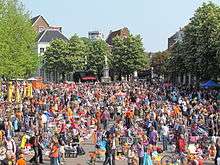
The vrijmarkt (literally 'free market') is a nationwide flea market, at which many people sell their used goods. Koningsdag is the one day of the year that the Dutch government permits sales on the street without a permit and without the payment of value added tax.[28] ING Bank found in 2011 that one in five Dutch residents planned to sell at the vrijmarkt and estimated they would earn €100 per person for a total turnover of €290 million. Over half of the Dutch people buy at the vrijmarkt; ING Bank predicted they would spend €28 each at the 2011 vrijmarkt.[29] Queen Beatrix has been known to buy at the vrijmarkt; in 1995 she purchased a floor lamp.[30] The bank also forecast that the lowest level of sales at the vrijmarkt in 2011 would be in the province of Limburg, site of Queen Beatrix's visit.[29]
Among the most popular areas for the vrijmarkt in Amsterdam is the Jordaan quarter, but the wide Apollolaan in front of the Hilton hotel in southern Amsterdam is gaining in popularity. Children sell their cast-off toys or garments at the Vondelpark, also in southern Amsterdam, and in a spirit of fun passers-by often offer the young sellers more than they are asking for the goods.[31] Until 1996 the vrijmarkt began the evening before and continued for 24 hours. This was ended in the hope of gaining a pause in the celebrations so preparations could be made for the daytime activities.[4] Utrecht, uniquely among Dutch municipalities, retains the overnight vrijmarkt.[20]
Festivities
Koningsdag now sees large-scale celebrations, with many concerts and special events in public spaces, particularly in Amsterdam. An outdoor concert is held on Amsterdam's Museumplein, where as many as 800,000 people may gather. To aid visitors in returning home by train after the festivities outdoor events must end by 20:00, and the Museumplein show by 21:00.[20] The city centre is closed to cars, and no trams ride in the heart of the city; people are urged to avoid Amsterdam Centraal railway station and use other stations if possible from their direction. International trains that normally begin or terminate at Amsterdam Centraal are instead directed to a suburban stop.[32]

In recent years parties and concerts have been held the evening before Koningsdag. Until 2013, nightclubs across the Netherlands organised special events for what became known as Koninginnenacht (Queen's Night).[33] Many young people celebrate in the streets and squares (and in Amsterdam, the canals as well) throughout the night, and after all-night partying join the crowds at the vrijmarkt.[13]
While King's Day celebrations take place throughout the Netherlands, Amsterdam is a popular destination for many revelers. Often the city's 750.000 residents are joined by up to 1 million visitors. In recent years Amsterdam authorities have taken some measures to try and stem the flow of visitors as the city became too full.[34]
Those taking part in Koningsdag commonly dye their hair orange or wear orange clothing in honour of the House of Orange-Nassau, which rules over the Netherlands. Orange-coloured drinks are also popular.[35] This colour choice is sometimes dubbed "orange madness", or in Dutch, oranjegekte.[13] A local Orange Committee member said of Koninginnedag in 2011:
Friendships—and community—will be formed. For me that’s really what Queen’s Day is all about. It’s not an outburst of patriotism, it’s not even about the popularity of the royal family. It’s about a sense of belonging. For one day, everybody is the same in Holland. Bright orange and barmy.[6]
Children celebrate with a variety of games including koekhappen (in which they catch spice cake dangling from a string in their mouths) and spijker poepen (in which they tie string around their waist a nail dangling at one end, which they attempt to lower into a glass bottle).[36]
Honours
Koningsdag is an opportunity for the monarch to honour citizens for their service to the Netherlands. In 2011, Queen Beatrix issued an honours list noting the work of 3,357 people, most of whom became members of the Order of Orange-Nassau.[37]
Observance in Netherlands territories outside Europe
Koningsdag is also celebrated in Aruba, Curaçao, and Sint Maarten, constituent countries of the Kingdom of the Netherlands.[13] It is less widely celebrated on the Caribbean island of Bonaire, also a part of the Kingdom, where the local celebration of Dia di Rincon (held on 30 April) is more popular.[38]
References
- 1 2 AZ (2013-04-30). "Besluit vaststelling en aanduiding zevenentwintigste april als Koningsdag" (in Dutch). BWBR0032908.
- 1 2 AZ (1980-04-24). "Besluit aanduiding van de dertigste april als Koninginnedag" (in Dutch). BWBR0031338.
- 1 2 3 4 5 6 "The Queen's official birthday (Koninginnedag)". Rijksvoorlichtingsdienst. Archived from the original on 6 May 2012. Retrieved 30 April 2012.
- 1 2 3 4 5 6 7 8 9 10 11 Peek, Mike (April 2011). "Long live the Queen". Amsterdam Magazine: 29–33. Retrieved 30 April 2011.
- 1 2 3 Deploige, Jeroen; Gita Deneckere (2006). Mystifying the Monarch: Studies on Discourse, Power, and History. Amsterdam: Amsterdam University Press. p. 187. ISBN 90-5356-767-4. Retrieved 6 May 2011.
- 1 2 3 Chadwick, Nicola (27 April 2011). "Planning the perfect Queen's Day". Radio Netherlands Worldwide. Retrieved 1 May 2011.
- ↑ Bates, Winslow (October 1898). "The girl queen and her coronation". National Magazine: 12–18. Retrieved 3 May 2011.
- 1 2 3 "Queen's Day history dates back to 1889". NIS News. 26 April 2001. Retrieved 1 May 2011.
- ↑ "Holland preparing for Queen's jubilee". The New York Times. 9 July 1923. p. 13. Retrieved 3 May 2011. (Subscription required (help)).
- 1 2 "Queen's Day of Netherlands April 30, 2011". Manila Bulletin. 30 April 2011. Retrieved 1 May 2011.
- ↑ Schorr, Danel L. (16 April 1949). "Dutch queen guides nations through crises, eyes first anniversary". The Christian Science Monitor. Retrieved 3 May 2011. (Subscription required (help)).
- ↑ Romanko, J.R. (19 March 2006). "Datebook". The New York Times. Retrieved 1 May 2011.
- 1 2 3 4 5 Thompson, Nick (25 April 2011). "Queen's Day: Go Dutch for an alternative royal celebration". CNN. Retrieved 1 May 2011.
- ↑ "Queen's Day". Expat Centre–Leiden. 13 April 2011. Retrieved 1 May 2011.
- ↑ Raines, Howell (2 May 1988). "3 British servicemen are killed In I.R.A. attacks in Netherlands". The New York Times. Retrieved 3 May 2011.
- ↑ Corder, Mike (1 May 1996). "Netherlands celebrates Queen Mother's birthday with national garage sale". AP via Lewiston Herald-Journal. Retrieved 3 May 2011.
- 1 2 "Koninginnedag" (in Dutch). Rijksvoorlichtingsdienst. Archived from the original on 7 June 2012. Retrieved 30 April 2012.
- 1 2 "Car crash into Dutch Queen parade". BBC. 30 April 2009. Retrieved 1 May 2011.
- ↑ "Geschiedenis Koningsdag" (in Dutch). Rijksvoorlichtingsdienst. Retrieved 26 April 2017.
- 1 2 3 "The Netherlands celebrates Queen's Day, royals in Limburg". dutchnews.nl. 30 April 2011. Retrieved 1 May 2011.
- ↑ "Dutch Queen announces Abdication". Guardian. 28 January 2012. Retrieved 28 January 2013.
- ↑ Anouk Eigenraam (28 January 2013). "Koninginnedag wordt Koningsdag en is voortaan op 27 april". NRC Handelsblad (in Dutch). Retrieved 29 January 2013.
- ↑ "Koningsdag vanaf 2014 op 27 april" (in Dutch). Rijksvoorlichtingsdienst. 28 January 2013. Retrieved 26 April 2017.
- ↑ "Koningsdag 2015 in Dordrecht" (in Dutch). Rijksvoorlichtingsdienst. 11 October 2014. Retrieved 26 April 2017.
- ↑ "Koningsdag 2016 in Zwolle" (in Dutch). Rijksvoorlichtingsdienst. 12 October 2015. Retrieved 26 April 2017.
- ↑ "Koningsdag 2017 in Tilburg" (in Dutch). Rijksvoorlichtingsdienst. 2 September 2016. Retrieved 26 April 2017.
- ↑ "Woerden: Oranjecomité zoekt sponsors" (in Dutch). RPLFM Woerden. 29 April 2011. Retrieved 5 May 2011..
- ↑ Chack, Erin (5 April 2011). "Queen's Day Amsterdam 2011 guide". TNT Magazine. Retrieved 1 May 2011.
- 1 2 "Nederlanders rekenen op 290 miljoen op vrijmarkt" (in Dutch). ING Group. 29 April 2011. Retrieved 30 April 2012.
- ↑ "National yard sale honors Dutch queen". AP via The Southeast Missourian. 1 May 1997. Retrieved 3 May 2011.
- ↑ "Free market on Queen's Day". amsterdam.info. Retrieved 1 May 2011.
- ↑ "Transportation during the Queen's Day". amsterdam.info. Retrieved 1 May 2011.
- ↑ "Queen's Day in Amsterdam". amsterdam.info. Retrieved 1 May 2011.
- ↑ "Amsterdam says new approach to Queen’s Day successful". dutchamsterdam.nl. Retrieved 26 April 2013.
- ↑ "Tradition of Queen's Day in Holland". amsterdam.info. Retrieved 1 May 2011.
- ↑ Thompson, Nick (25 April 2011). "Queen's Day: Go Dutch for an alternative royal celebration - CNN.com". CNN. Retrieved 29 April 2015.
- ↑ "Dutch Queen's Day honours list". Radio Netherlands Worldwide. 29 April 2011. Retrieved 1 May 2011.
- ↑ "Dia di Rincon populairder dan Koninginnedag op Bonaire" (in Dutch). Radio Netherlands Worldwide (Caribbean). 2 May 2011. Retrieved 3 May 2011.
External links
-
 Media related to Koningsdag at Wikimedia Commons
Media related to Koningsdag at Wikimedia Commons -
 Media related to Koninginnedag at Wikimedia Commons
Media related to Koninginnedag at Wikimedia Commons
